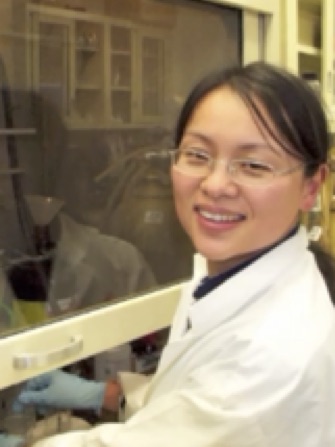Org. Synth. 2017, 94, 54-65
DOI: 10.15227/orgsyn.094.0054
Ugi Multicomponent Reaction
Submitted by André Boltjes, Haixia Liu, Haiping Liu, and Alexander Dömling
*1
Checked by Emma L. Baker-Tripp and Neil K. Garg
1. Procedure
A.
N-(2,2-Dimethoxyethyl)-N-(2-oxo-2-(phenethylamino)ethyl)cylcohexane-carboxamide. Into a 500 mL 3-necked, round-bottomed flask, equipped with a 6 cm Teflon blade overhead stirrer (
Note 1), a 60-mL pressure equalizing dropping funnel holding a nitrogen inlet and a thermocouple (Figure 1), is added a mixture of
N-(phenethyl)formamide (7.46 g, 50 mmol) and
triethylamine (16.8 mL, 120 mmol 2.4 equiv) in
dichloromethane (50 mL) (
Note 2). The solution is cooled to approximately -10 °C using an ethanol-ice bath (
Note 3).
Figure 1. Reaction set-up
Triphosgene (5.94 g, 20 mmol, 0.4 equiv) (
Note 4) in
dichloromethane (20 mL) is added dropwise to the stirring (500 rpm) mixture via the dropping funnel over a period of 45 min (
Note 5), resulting in a dark red/brown solution. The reaction mixture is stirred at -10 °C for an additional 30 min (
Note 6) (Figure 2).
Figure 2. Color changes as reaction progresses
A separate 50 mL round-bottomed flask, which is charged with a mixture of
aminoacetaldehyde dimethyl acetal (5.52 g, 52.5 mmol, 1.05 equiv) and
paraformaldehyde (1.50 g, 50 mmol, 1 equiv) in 50 mL
methanol, is equipped with an air condenser and heated to 80 °C in an oil bath with stirring until a clear solution developed. After allowing the solution to cool to room temperature,
cyclohexanecarboxylic acid (6.72 g, 52.5 mmol, 1.05 equiv) is added. The resulting solution is then added together with another 50 mL
MeOH to the in situ formed isocyanide reaction mixture at -10 °C via cannula. The reaction mixture is left to warm to room temperature. The overhead mechanical stirrer and 60-mL pressure equalizing dropping funnel are replaced with red septa and a 2.5 cm Teflon stir bar (Figure 3).
Figure 3. Post-reagent addition set-up
After stirred at room temperature for 48 h (
Note 7), the reaction mixture is transferred to a 1000 mL one-necked, round-bottomed flask, along with
CH2Cl2 (100 mL) that is used to rinse the flask, and the solution is concentrated by rotary evaporation (40 °C, 7.5 mmHg) to remove the
methanol. Then the mixture is redissolved in
CH2Cl2 (50 mL) and transferred to a 250 mL separatory funnel, washed with water (3 x 50 mL), saturated
NaHCO3 (3 x 50 mL), and dried over
MgSO4 (10g). The drying agent is removed by filtration through a medium porosity 150 mL filter funnel (200 mmHg applied vacuum), and the resulting solution is collected into a 1000 mL round-bottomed flask, in which the solution is concentrated by rotary evaporation (40 °C, 7.5 mmHg) (
Note 8).
Figure 4. Appearance of the Ugi product for checkers before and after solvent removal
The red/brown oil is purified by flash chromatography on silica using hexanes and ethyl acetate as the eluent (Note 9). The collected fractions are placed in a 1000-mL round-bottomed flask and then concentrated by rotary evaporation (40 °C, 7.5 mmHg) to yield a reddish-brown oil (picture above) which is then placed under high vacuum (45 °C, 0.2 mmHg) for 12 h (Note 10) to afford 7.46 g (46%, >99% purity) of N-(2,2-dimethoxyethyl)-N -(2-oxo-2-(phenethylamino)-ethyl)cylcohexanecarboxamide as a brown solid (Figure 4) (Notes 11 and 12).
2. Notes
1. The Teflon blade overhead stirrer was purchased from Arrow Engineering Mixing Products, model #1750; 115 VAC 60 Hz.
2. Reagents and solvents used in this preparation are commercially available and used without further purification, including solvents
dichloromethane and
methanol, which were purchased from Fisher Chemical.
Triphosgene (98%) and
aminoacetaldehyde dimethyl acetal (99%) from AK Scientific Inc.,
N-(phenethyl)formamide (97%),
trimethylamine (≥99%),
paraformaldehyde (95%) and
cyclohexane carboxylic acid (≥98%) from Sigma Aldrich.
3. In a 1L Dewar cooling bath 275 g ice and 150 g ethanol were used to obtain a temperature of approximately -10 °C for the duration of the reaction. Checkers utilized the thermocouple in the ice/ethanol bath to accurately measure for the duration of the reaction.
4. The solid reagent
triphosgene is a less hazardous substitute for highly toxic gaseous phosgene, however should be handled very carefully.
Triphosgene may be fatal if inhaled and causes burns by all exposure routes. This water-reactive substance liberates toxic gas upon exposure to water.
Triphosgene is a lachrymator and can decompose violently at elevated temperatures.
Triphosgene should be weighed out and the reaction should be performed in a well-ventilated fume hood.
5. Faster addition or temperatures above 0 °C will reduce the yield dramatically. Submitters noted that color is a good indicator of proper addition speed: slightly yellow color is good, orange towards brown indicates too fast addition of
triphosgene.
6. The isocyanide intermediate Rf
= 0.80 (1:1 Hexanes:EtOAc), checked by TLC EMD gel 60 F254 pre-coated plates (0.25 mm) (visualized with 254 nm UV lamp), appears nearly exclusively indicating consumption of the formamide (Figure 5).
Figure 5. TLC analysis of isocyanide formation
7. Not all reagents are fully consumed, but after 48 h no change in spot intensity, checked by TLC EMD gel 60 F254 pre-coated plates (0.25 mm) (visualized with 254 nm UV lamp), was observed.
Figure 6. TLC analysis of multi-component reaction
8. The bulk of solvent should be removed; however, leaving a trace of solvent (~0.5 g) is actually beneficial in allowing the product to crystallize. The crystallization process requires time (up to 2 weeks). The submitters report a yield of 9.05 g crude product. The submitters then triturate the crude crystals with 10 mL cold
Et2O, filtering through a P4 glass filter and washing with another 10 mL cold
Et2O. Yields after drying (0.5 mbar) 7.56 g (40%) pure
N-(2,2-dimethoxyethyl)-N-(2-oxo-2-(phenethylamino)ethyl)cylcohexanecarb-oxamide as pale yellow crystals (Figure 7).
Figure 7. Appearance of the Ugi product from submitters
9. The column chromatography was run as follows: A flash column with an outer diameter of 8 cm and capacity of 2000 mL was charged with silica (Silicycle Siliaflash P60 particle size 0.040-0.063 mm purchased from Silicycle; used as received) using a wet-pack method (316 g of silica in 700 mL of 66% hexanes in
ethyl acetate). This gave a silica bed of 16 cm in height. The crude mixture was then dissolved in 15 mL of 66% hexanes in
ethyl acetate and then loaded onto the silica using a pipette. Sand was then added to fill 2 cm above the silica. An eluent mixture of 66% hexanes in
ethyl acetate (1300 mL) was used initially, followed by 50%
ethyl acetate in hexanes (2000 mL) and 100%
ethyl acetate (3000 mL). The flow rate was approximately 66 mL/min and 30-mL fractions were collected. Fractions 148-182 were then collected as the product fractions.
10. The checkers found that
ethyl acetate was difficult to remove. Placing the purified reddish-brown oil under high vacuum (45 °C, 0.2 mmHg) for 12 h was required to remove the
ethyl acetate.
11.
N-(2,2-Dimethoxyethyl)-N-(2-oxo-2-(phenethylamino)ethyl) cyclohex-anecarboxamide: mp = 83.4-85.2 °C, R
f = 0.42 (100% EtOAc)
1H NMR
pdf(500 MHz, CDCl
3) δ: 1.16-1.30 (m, 3H), 1.37-1.52 (m, 2H), 1.56-1.71 (m, 2H), 1.71-1.82 (m, 2H), 2.24 (tt,
J = 11.5, 3.4 Hz, 0.5H), 2.58 (tt,
J = 11.5, 3.4 Hz, 0.5H), 2.80 (dt,
J = 20.6, 7.2 Hz, 2H), 3.33 (s, 3H), 3.37 (s, 3H), 3.42 (app t,
J = 4.8 Hz, 2H), 3.49 (q,
J = 6.7 Hz, 1H), 3.55 (q,
J = 6.8 Hz, 1H), 3.98 (d,
J = 6.5 Hz, 2H), 4.39 (t,
J = 5.3 Hz, 0.5H), 4.57 (t,
J = 5.1 Hz, 0.5H), 6.41-6.50 (m, 0.5H), 6.94-7.00 (m, 0.5H), 7.16-7.25 (m, 3H), 7.27-7.32 (m, 2H);
13C NMR
pdf(125 MHz, CDCl
3) δ: 25.7, 25.8, 25.9, 29.4, 29.5, 35.7, 35.8, 40.4, 40.6, 40.8, 41.2, 50.5, 51.6, 52.3, 54.2, 55.2, 55.6, 102.8, 103.6, 126.6, 126.8, 128.7, 128.8, 128.9, 138.7, 138.9, 169.4, 169.7, 178.0, 178.2; IR (film): 3301, 2929, 2854, 1627, 1544, 1451 cm
-1. HRMS (ESI). [M + H]
+ calcd. for C
21H
33O
4N
2: 377.2440. Found: 377.2408. The tertiary amide rotamers are clearly visible in the NMR spectrum and show a 1:1 ratio. The purity of the compound was determined using qNMR: 14.1 mg of the product are dissolved in 0.8 mL of CDCl
3. 1,3,5-trimethoxybenzene, 10.2 mg (99%, purchased from Alfa Aesar and used as received), is added as the internal standard.
1H NMR
pdf(500 MHz, CDCl
3) gave a product purity of 99.2%.
12. A second reaction provided the product as a brown solid in 46%.
Working with Hazardous Chemicals
The procedures in
Organic Syntheses are intended for use only by persons with proper training in experimental organic chemistry. All hazardous materials should be handled using the standard procedures for work with chemicals described in references such as "Prudent Practices in the Laboratory" (The National Academies Press, Washington, D.C., 2011; the full text can be accessed free of charge at
http://www.nap.edu/catalog.php?record_id=12654). All chemical waste should be disposed of in accordance with local regulations. For general guidelines for the management of chemical waste, see Chapter 8 of Prudent Practices.
In some articles in Organic Syntheses, chemical-specific hazards are highlighted in red "Caution Notes" within a procedure. It is important to recognize that the absence of a caution note does not imply that no significant hazards are associated with the chemicals involved in that procedure. Prior to performing a reaction, a thorough risk assessment should be carried out that includes a review of the potential hazards associated with each chemical and experimental operation on the scale that is planned for the procedure. Guidelines for carrying out a risk assessment and for analyzing the hazards associated with chemicals can be found in Chapter 4 of Prudent Practices.
The procedures described in Organic Syntheses are provided as published and are conducted at one's own risk. Organic Syntheses, Inc., its Editors, and its Board of Directors do not warrant or guarantee the safety of individuals using these procedures and hereby disclaim any liability for any injuries or damages claimed to have resulted from or related in any way to the procedures herein.
3. Discussion
The Ugi multicomponent reaction of amines, oxo components, isocyanides and inorganic or organic acids leads to different scaffold types dependent on the nature of the acid component.
2 For example carboxylic acids yield α-amino acylamides (Table 1). The Ugi multicomponent reaction is gaining increasing attention due to the rapid and convergent assembly of functional structures based on four classes of widely available starting material classes.
3 In addition, our recent work on generating the isonitrile
in situ is making the Ugi reaction even more attractive, as the isolation of the infamous isonitrile is circumvented in this methodology.
4 While several approaches towards α-amino acylamides are possible, the Ugi approach is faster and moreover impresses by a very large substrate scope.
5 Here the Ugi intermediate to the schistosomiasis drug praziquantel (PQZ, 2-(cyclohexanecarbonyl)-2,3,6,7-tetrahydro-1H-pirazino[2,1-a]isoquinolin-4(11bH)-one) is prepared to exemplify the usefulness of this methodology. It comprises a one-pot synthesis from the readily available bulk starting materials, 2-phenylethyl formamide, formaldehyde, cyclohexancarboxylic acid and aminoacetaldehyde dimethylacetal. N-Phenethylformamide reacts with
triphosgene, which in turn reacts with
paraformaldehyde, aminoacetaldehyde dimethylacetal, and cyclohexylcarboxylic acid in an Ugi four component reaction to the advanced praziquantel precursor in 46% yield.
7 Many similar derivatives have been synthesized accordingly (Table 1).
7
Table 1. Examples of Ugi products and their yields
Appendix
Chemical Abstracts Nomenclature (Registry Number)
N-(Phenethyl)formamide (23069-99-0)
Triphosgene (32315-10-9)
Triethylamine (121-44-8)
Paraformaldehyde; (30525-89-4)
Aminoacetaldehyde dimethyl acetal; (22483-09-6)
Cyclohexane carboxylic acid; (98-89-5)
N-(2,2-Dimethoxyethyl)-N-(2-oxo-2-(Phenethylamino)ethyl)cylcohexanecarboxamide; (90142-13-5)

|
Alexander Dömling studied chemistry & biology at the Technical University Munich. After performing his Ph.D. under the supervision of Ivar Ugi he spent his postdoctoral year at the Scripps Research Institute in the group of Barry Sharpless under a prestigious Feodor Lynen research fellowship from the Alexander von Humboldt society. He is founder of several biotech companies, including Morphochem, Telesis and SMIO. In 2004 he performed his habilitation in chemistry at the Technical University of Munich. Since 2006 he was Professor at the University of Pittsburgh in the Department of Pharmacy and Chemistry and in 2011 he became Chair of Drug Design at the University of Groningen. He is author of more than 200 papers, reviews, book contributions and patents. His research interest focuses on novel aspects of multicomponent reaction chemistries and its applications to drug design. |

|
André Boltjes was born in the Netherlands. He received his Bachelor's degree in 2007 from Hanze University and started working at the University of Groningen, developing dopamine agonists, HAT inhibitors, doxorubicin prodrugs and performing various contract synthesis projects. In 2011 he joined Dömling's group as a technician in University of Groningen. |

|
Haixia Liu was born in Tianjin, China. She received her undergraduate chemistry degree at Nanjing University in 2002. Then, she moved to Shanghai, China to pursue her doctoral studies with Dr. Zhu-Jun Yao at the Shanghai Institute of Organic Chemistry, where she studied chemical biology with particular focus on mimetics of Annonaceous acetogenin. In January 2008, she came to the U.S. to start her post-doctoral work with Dr. Alexander Dömling at the University of Pittsburgh to study multi-component reactions to build small-molecule libraries. She then continued her post-doctoral work when she came to UCLA in January 2009, where she is now working on syntheses of ghrelin O-acyltransferase (GOAT) inhibitors. Currently she is working for Roche/Shanghai. |

|
Haiping Cao was born in Zhejiang, China. She received her BA degree in 2002 from Fudan University, China. After five years of studies, She obtained her PhD in organic chemistry from Shanghai Institute of Organic chemistry, China under the supervision of Professor Qingyun Chen in 2007. Her dissertation focused on new methodology to synthesize fluorinated compounds. In 2009 she joined Professor Alexander Dömling's group as a postdoctoral associate at the University of Pittsburgh. |

|
Emma L. Baker-Tripp received her B.A. in chemistry from Grinnell College in 2013. She is currently pursuing her Ph.D. in organic chemistry in the laboratory of Professor Neil K. Garg at the University of California, Los Angeles. Her graduate research has focused on the total synthesis of welwitindolinone alkaloids and the development of new C-C and C-heteroatom bond forming reactions of amides mediated by nickel catalysis. |
Copyright © 1921-, Organic Syntheses, Inc. All Rights Reserved